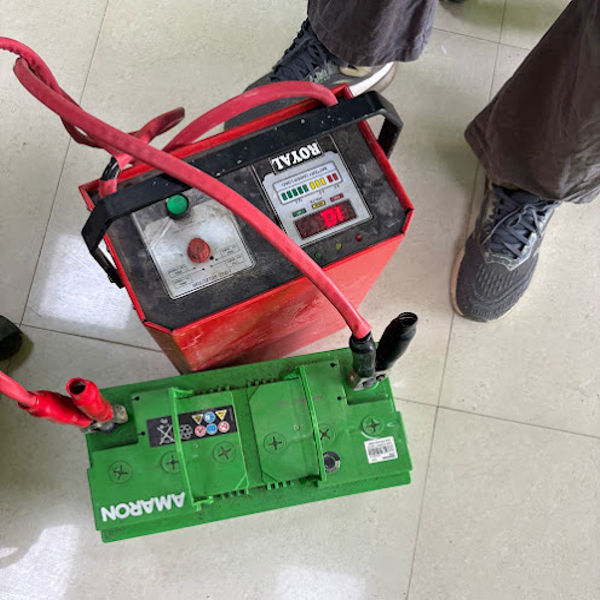Battery repair and maintenance are essential for ensuring the longevity and optimal performance of batteries, especially for lead-acid batteries like the Amaron 12V 42AH. Here are some key aspects of battery repair and maintenance: 1. Regular Inspection Visual Checks: Inspect batteries for any signs of physical damage, corrosion, or leaks. Terminals: Ensure that battery terminals are clean and free from corrosion. Use a mixture of baking soda and water to clean corroded terminals. 2. Cleaning Battery Case: Wipe the battery case with a damp cloth to remove dirt and grime. Terminals: Clean terminals with a wire brush or terminal cleaner to ensure good electrical contact. 3. Checking Electrolyte Levels (for Flooded Lead-Acid Batteries) Electrolyte Levels: If applicable, check the electrolyte levels in each cell. Top up with distilled water if levels are low, but avoid overfilling. Sealed Batteries: For sealed batteries (like AGM or Gel), this step is not applicable. 4. Charging Proper Charging: Use a compatible charger and follow the manufacturer's guidelines for charging. Avoid overcharging, which can damage the battery. Trickle Charging: For batteries that are not used frequently, consider using a trickle charger to maintain charge levels. 5. Temperature Management Storage Conditions: Store batteries in a cool, dry place. Extreme temperatures can affect battery performance and lifespan. Operating Temperature: Ensure that the battery operates within the recommended temperature range. 6. Load Testing Performance Check: Periodically perform a load test to check the battery's ability to hold a charge and deliver power. This can help identify weak or failing batteries. 7. Battery Replacement Signs of Failure: If a battery shows signs of significant wear, such as reduced capacity or inability to hold a charge, it may need to be replaced. Compatibility: When replacing batteries, ensure that the new battery is compatible with the existing system. 8. Disposal Proper Disposal: Follow local regulations for disposing of batteries. Lead-acid batteries are hazardous waste and should be recycled at designated facilities. 9. Safety Precautions Personal Protective Equipment (PPE): Wear gloves and safety goggles when handling batteries to protect against acid spills and corrosion. Ventilation: Ensure good ventilation when charging batteries to avoid the buildup of harmful gases. 10. Professional Help Consult Experts: If you are unsure about any maintenance or repair tasks, consult a professional technician or battery specialist.
Chat with us on WhatsApp
×
This is your website preview.
Currently it only shows your basic business info. Start adding relevant business details such as description, images and products or services to gain your customers attention by using Boost 360 android app / iOS App / web portal.
Battery repair and maintenance are essential fo...

2025-04-30T10:21:24
Battery repair and maintenance are essential for ensuring the longevity and optimal performance of batteries, especially for lead-acid batteries like the Amaron 12V 42AH. Here are some key aspects of battery repair and maintenance: 1. Regular Inspection Visual Checks: Inspect batteries for any signs of physical damage, corrosion, or leaks. Terminals: Ensure that battery terminals are clean and free from corrosion. Use a mixture of baking soda and water to clean corroded terminals. 2. Cleaning Battery Case: Wipe the battery case with a damp cloth to remove dirt and grime. Terminals: Clean terminals with a wire brush or terminal cleaner to ensure good electrical contact. 3. Checking Electrolyte Levels (for Flooded Lead-Acid Batteries) Electrolyte Levels: If applicable, check the electrolyte levels in each cell. Top up with distilled water if levels are low, but avoid overfilling. Sealed Batteries: For sealed batteries (like AGM or Gel), this step is not applicable. 4. Charging Proper Charging: Use a compatible charger and follow the manufacturer's guidelines for charging. Avoid overcharging, which can damage the battery. Trickle Charging: For batteries that are not used frequently, consider using a trickle charger to maintain charge levels. 5. Temperature Management Storage Conditions: Store batteries in a cool, dry place. Extreme temperatures can affect battery performance and lifespan. Operating Temperature: Ensure that the battery operates within the recommended temperature range. 6. Load Testing Performance Check: Periodically perform a load test to check the battery's ability to hold a charge and deliver power. This can help identify weak or failing batteries. 7. Battery Replacement Signs of Failure: If a battery shows signs of significant wear, such as reduced capacity or inability to hold a charge, it may need to be replaced. Compatibility: When replacing batteries, ensure that the new battery is compatible with the existing system. 8. Disposal Proper Disposal: Follow local regulations for disposing of batteries. Lead-acid batteries are hazardous waste and should be recycled at designated facilities. 9. Safety Precautions Personal Protective Equipment (PPE): Wear gloves and safety goggles when handling batteries to protect against acid spills and corrosion. Ventilation: Ensure good ventilation when charging batteries to avoid the buildup of harmful gases. 10. Professional Help Consult Experts: If you are unsure about any maintenance or repair tasks, consult a professional technician or battery specialist.
2025-04-30T10:21:24
Keywords
- compatible charger
- distilled water
- electrolyte levels
- applicable check
- professional technician
- acid spills
- safety goggles
- hazardous waste
- replaced compatibility
- reduced capacity
- significant wear
- identify weak
- deliver power
- batterys ability
- load test
- manufacturers guidelines
- cell top
- terminal cleaner
- wire brush
- remove dirt
- damp cloth
- baking soda
- key aspects
- handling batteries
- sealed batteries
- battery specialist
- battery operates
- battery case
- consult experts
- trickle charger
- optimal performance
- battery repair
- leadacid batteries
- battery terminals
- charging batteries
- batteries leadacid batteries
- physical damage corrosion
- battery shows signs
- battery trickle charging
- charging avoid overcharging
- affect battery performance
- repair tasks consult
- replacing batteries ensure
- leaks terminals ensure
- amaron 12v 42ah

Submit Your Enquiry